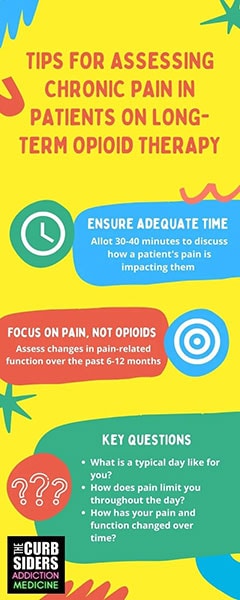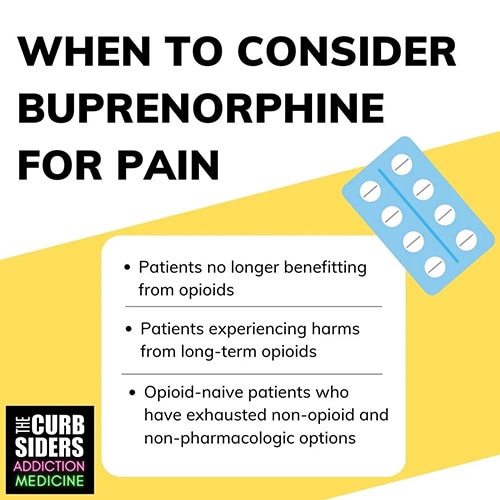This transcript has been edited for clarity.

Carolyn A. Chan, MD: Welcome back to The Curbsiders addiction medicine podcast, where we use expert interviews to bring you clinical pearls and practice-changing knowledge on substance use disorders. I'm Dr Carolyn Chan, and today I'm joined by my friend, Dr Kenny Morford.
Kenneth Morford, MD: Today we're going to recap a recent podcast episode on buprenorphine for chronic pain. Our podcast featured Dr Will Becker from the Yale School of Medicine.
Chan: We learned a ton from Dr Becker, so make sure you check out the full-length podcast episode. One of the main pearls I took away was to make sure that we have adequate time during the patient visit to assess chronic pain and long-term opioid use. Dr Becker recommended trying to block off 30-40 minutes for this discussion and really hone in on the patient's pain and pain experience.
Key questions you may want to ask include:
What does a typical day look like for you?
How does pain limit you throughout the day?
How has your pain and function changed over time?
Be sure to tune your ears for any evidence of declining function or sedentary lifestyle. If the picture is one of declining function, adverse effects from opioids, or a lack of meaningful benefit in the patient's own view, it implies either a low benefit or absence of benefit from opioid therapy. This may be a sign that it's time to rethink the treatment plan.
Kenny, can you remind us how to diagnose opioid use disorder (OUD) in patients on long-term opioid treatment?
Morford: We diagnose OUD using the DSM-5 criteria. A key point to remember, though, is that for patients who are prescribed long-term opioid therapy, the criteria of tolerance and withdrawal should not be applied, because tolerance and withdrawal are expected physiologic changes that can develop in someone prescribed long-term opioid therapy. Dr Becker doesn't think that an OUD diagnosis is appropriate unless the patient clearly demonstrates loss of control over their opioid use. And a caveat to this is that the loss-of-control criteria may not be related to OUD if a patient is struggling while they're undergoing a clinician-driven opioid taper. The key point is to only assess for OUD when a patient is receiving their current dose of prescribed opioids.
Can you remind us how buprenorphine works and in which patients with chronic pain to consider using this form?
Chan: Buprenorphine is a partial opioid agonist that has high affinity for the mu opiate receptor. It has a ceiling effect on respiratory depression and typically fewer side effects than full opioid agonists, yet it can be effective for pain management. For some individuals, a switch to buprenorphine from a full opiate agonist may actually improve their pain control and quality of life.
Dr Becker provided us with a couple of situations where he thinks we should consider using buprenorphine for chronic pain.

First consider patients who are no longer benefiting from full agonist treatment or who are experiencing active harms on long-term opioid therapy. It's also reasonable to consider an opioid-naive patient who has exhausted all the nonopioid and nonpharmacologic pain management modalities. Dr Becker is more likely to use buprenorphine for chronic pain in older patients who are opioid naive to avoid opioid physiologic dependence in younger patients.
What tips did Dr Becker give us on how to transition a patient who is currently on opioids to buprenorphine?
Morford: There are two ways to transition a patient from long-term opioid therapy to buprenorphine — traditional and overlap methods.
The traditional approach involves having patients stop taking full opioid agonists, and then wait for withdrawal symptoms to develop before they start buprenorphine. With a short-acting opioid, this takes about 12 hours; with a longer-acting opioid, it's 24-72 hours before the patient can start taking buprenorphine.
With the overlap method (also called the low-dose method) of transitioning patients, a low dose of buprenorphine is started while the patient continues the full opioid agonist. The buprenorphine is then titrated slowly up every day until they reach a therapeutic dose. At that point, the full opioid agonist is stopped. This process usually takes 5-7 days.
Dr Becker said the overlap method is now his preferred approach, and he gave us tips for using this method successfully:
Determine which buprenorphine formulation the patient will switch to by calculating the morphine milligram equivalents (MME).
Find out which buprenorphine products are covered by your patient's insurance to make sure they can access the medication. There are a lot of different formulations, and insurances often don't cover all of the available products.
Make sure that patients understand this process by asking them to do a teach-back of the steps that are involved.
Listen to our full podcast and check out our show notes for specific protocols on how to transition these patients to buprenorphine using the overlap or low-dose method.
Follow Medscape on Facebook, X (formerly known as Twitter), Instagram, and YouTube
Credits:
Image 1: The Curbsiders
Image 2: The Curbsiders
© 2023 WebMD, LLC
Cite this: Buprenorphine for Chronic Pain: How to Prescribe It - Medscape - Aug 21, 2023.










Comments